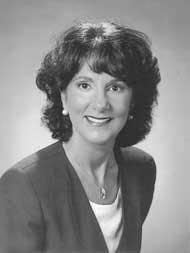over coffee
by Cathy Hester Seckman, RDH
. . . . . . A visit with Lynda Sabat . . . . . . . .
Sitting in a coffee shop in Brecksville, Ohio, waiting for Lynda Sabat, I have to confess that I experienced some “butterflies.” This wasn’t just any hygienist coming for an interview; this was the president of the Ohio State Dental Board. This was a faculty member from Cuyahoga Community College. This was an examiner for the Northeast Regional Board of Dental Examiners. This was an Ohio Dental Hygienists’ Association Service Award winner. Sabat is the real thing. Who was I, with a lowly associate’s degree and a two-day-a-week job in a pedo practice, to interview her?
It turned out, of course, that there was no reason to worry. Sabat isn’t successful just because she’s smart and aggressive and highly educated. She’s also friendly and practical, and her personality only adds to her success in the world of dentistry.
Forces for good
Hygienists sometimes see themselves as powerless. The truth is that we’re not. Hygienists have effected important changes in the dental world; we are and will continue to be forces for good.
But still, an individual hygienist might not feel that she or he has much influence outside the operatory.
Meet Lynda Sabat, RDH, MA, whose influence is stretching statewide and beyond. She’s a great example of how one hygienist can move and shake her profession.
A member of the Ohio State Dental Board since 1995, she has served on its Education Committee, Waiver Committee, and Laws and Rules Committee. She serves as its president for the 2004-2005 term. As president of the board, she works on furthering the mission of the board to regulate the practice of dentistry and dental hygiene by regulating and enforcing the standards of practice that will protect the public.
Sabat is the only hygienist to have served two, five-year terms on the state board. New legislation limits hygienists to two, four-year terms.
For the past nine years, she has also been one of 450 examiners for the Northeast Regional Board of Dental Examiners (a lifetime appointment), and she’s an active member of the American Association of Dental Examiners. Her resume includes terms as president of the Cleveland Dental Hygienists’ Association and the Ohio Dental Hygienists’ Association. She received the ODHA Service Award in 2003.
Sabat is also a member of the Alliance of the American Dental Association, a spouses’ organization. “We do school presentations. I just retired my tooth fairy costume to a younger member. I made it from one of my daughter’s old prom dresses. We won a national ADA competition one year for having the largest public Child Dental Health Day in the nation.”
Is that enough? No, Sabat also serves on the Chamber of Commerce’s Tree Commission in Brecksville (which bills itself as Tree City, USA), and is organizing the chamber’s 10th annual Taste of Brecksville Fair on the Square.
Sabat is a part-time clinician in Cleveland, and an adjunct faculty member of the dental hygiene program at Cuyahoga Community College in Cleveland. She and her husband, orthodontist Michael R. Sabat, DDS, MS, have three grown children.
Sabat started out as we all did, just wanting to be a hygienist. “I graduated from Cuyahoga Community College in 1967 with an associate’s degree and started practicing full-time. After we had our children, I went back for my bachelor’s in education at the University of Akron and started teaching part-time. Then I decided to go for my master’s in health education in 1981.”
It was a difficult time for the family. “The room where I worked was off-limits to the kids under penalty of death. My thesis was laid out all over the place. I kept thinking I was never going to graduate, but the kids said, ‘Yes, you are.’
“We all suffered, but it was worthwhile. I think it was encouraging for my children to see me struggle and get through it. They all have master’s degrees or more, now.”
Still time for clinical hygiene
Though her schedule is filled with meetings and classes and responsibilities, Sabat still makes time for clinical hygiene, filling in at different offices when she’s not teaching.
She’s also in touch with the dental board’s main office in Columbus daily, either by phone or email. She travels to Columbus at least once a month for meetings. Three or four times a year, she travels around the country to officiate at licensing exams. As a member of the NERB executive committee, she attends regular meetings in Washington, D.C.
Perfectly suited
Electing a hygienist as president of the Ohio State Dental Board makes perfect sense, Sabat believes. “The licensees of the Ohio Dental Board are dentists and hygienists,” Sabat explains. “It’s only logical to have a hygienist as board president, and I’m not the first one.” Kathy Goldberg was the first hygienist to serve on the board in the 1980s, Sabat recalls, and she was also the first hygienist to serve a term as president.
When Sabat was appointed to the board in 1995, she started slowly. “It was a steep learning curve. It takes a couple of years to learn the players and the rules, and to become knowledgeable in committees. The board thought I’d do best on the education committee, which is a lot of hard work.”
The board didn’t know what it had in Sabat. “I’m a teacher, so I’ve always been very organized, and I’m always working harder than the next guy. Whenever they gave me a task, I’d do it beyond their wildest dreams. Finally, they said, ‘This woman deserves to be president.’”
During her presidency, Sabat has clearly defined goals. “I have a positive outlook to fulfill the mission of the board to protect the public through its licensing, enforcement,and regulatory functions. It is only through collaborative efforts with all members of dentistry that the dental health needs of Ohio citizens can be improved."
Specifically, her goals are expansion of practice for all auxiliaries. “In hygiene especially, we need to be able to do local anesthesia. There’s a bill in committee, and our students are already getting didactic training in local anesthesia.”
In another area, which Sabat calls being “out on a skinny branch,” she’d like to initiate a safety net triage program in which hygienists could do assessments, take X-rays, and apply sealants for underserved populations.
“Someone has to address those issues (with the underserved public),” Sabat says. “We also have House Bill 51, which would allow a new dentist who provides access to care in a rural area to have his education paid for.”
Sabat is also considering the question of allowing hygienists to work unsupervised in nursing homes. “That could be very successful, but I have mixed feelings about it. We need more education and experience first.”
Issues of expansion aside, Sabat believes dentistry must always be a collaborative effort. “Autonomy has been an underlying movement for a number of years, but hygienists are an integral part of dentistry. Our charge is to work in collaboration with dentists. It’s the only way hygienists can successfully care for their clients.”
To other hygienists who want to reach for higher goals, Sabat says, “Being who you are, doing what you love, and being fair opens up all sorts of possibilities and opportunities. Don’t hesitate to get more education whenever you have the opportunity. Be prepared for whatever poses itself to you.”
Cathy Hester Seckman, RDH, is a frequent contributor based in Calcutta, Ohio. She can be reached at [email protected].


